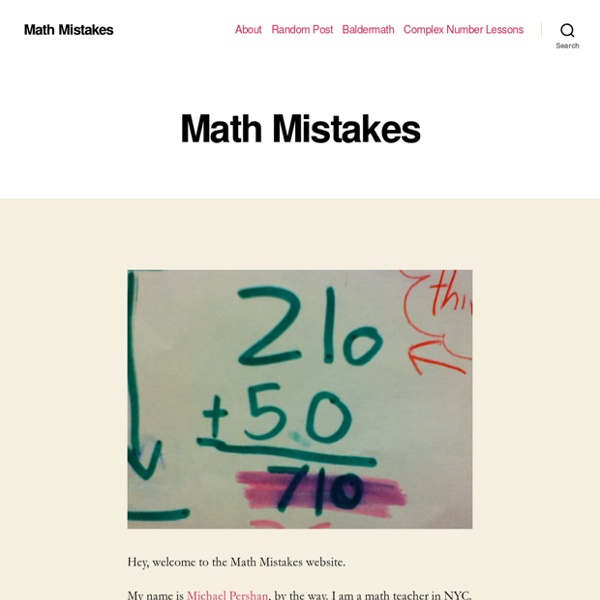Zoom
Trash
Related: Math Resources



How Single-Point Rubrics Can Improve The Quality Of Student Work How Single-Point Rubrics Can Improve Student Work by Drew Perkins Developing and using rubrics with students has long been a challenge for educators. Count On Count On Resources Resources: Misconceptions in Mathematics The Math Projects Journal I added two components to a lesson task on rational equations.The first was an idea called, Hint Cards, shared by Michael Pershan at Shadow Con at NCTM 2015. The second, which I will discuss in another post, was having students use Desmos to confirm answers that they found algebraically. There were so many surprising positives from this lesson that I have to share. As always, lesson awesomeness starts with a good task. The class had studied the simplifying, solving and graphing of rational functions. It was time to write and apply them.
Illustrative Mathematics Make sure you have plenty of snap cubes. A dubsnap is a length equal to two snap cube edges. Build a cube using 8 snap cubes of one color. Call this a dubsnap cube, with side length equal to 1 dubsnap, so it has a volume of  cubic dubsnap. How long (in dubsnaps) are the side lengths of a single snap cube?
Teachers Magazine - Issue 42 January 2006 Everyone knows the feeling of struggling with a task that other people seem to breeze through. It might be programming the DVD player or even just reading maps. Well, this is how some kids feel with maths, and their difficulties are often rooted in misunderstandings of concepts that we, as teachers, don't give a second thought to. How much could we help them make progress if we were more aware of these misconceptions, and were able to tackle them head-on? Search results for Kinesthetic What is Blue Tape Math? Simply put, it is having your students use blue masking tape to represent math on the wall, floor desk or windows. Why use Blue Tape in Math? MATH: Students are using ratios, scale models, fractions, decimals and graphs ALL THE TIME.
Building Thinking Classrooms If you've ever attempted to run a math or science lesson and haven't heard about Peter Liljedahl’s research yet, then you definitely need to get up to speed! Based out of Simon Fraser University, Peter Liljedahl works on mathematics pedagogy research that tries to answer one basic fundamental question; how can we get students thinking in class. All too often, students in classrooms aren't actually driven to tackle problems.
Teaching Through Problem Solving - NUMERACY in GPCSD Celebrating 100 Years with Big Beautiful Problems (Grades 6–8) - Alicia Burdess and Jessie Shirley100 Days of Professional Learning, Online with the National Council of Teachers of MathematicsBig Beautiful Problems can be life-changing for teachers and students alike as they show how math becomes alive and is connected to our world. See how much fun math can be as we get caught up in the challenge, excitement, and flow of learning. Deepen your skills, confidence, and joy as we experience and explore some of our favorite problems. Teaching Through Problems Worth Solving ResourceInquiry-based, Curriculum-linked, Differentiated Math Problems for Grade 8
Illustrative Mathematics Make sure you have plenty of snap cubes. Build a rectangular prism that is 2 cubes on one side, 3 cubes on another, and 5 cubes on the third side. We will say that the volume of one cube is 1 cubic unit. What is the volume of the rectangular prism? Jenna said, The rectangular prism is 2 cubes by 3 cubes by 5 cubes, so the volume of the prism is cubic units.
Engaging Math: group sort cards If you want a quick activity that you can use to randomly put students into groups of four, look no further. This activity uses fractions with common denominators and then equivalent fractions to sort students into groups. This could be used with any class where students can add fractions and compare equivalent factions.